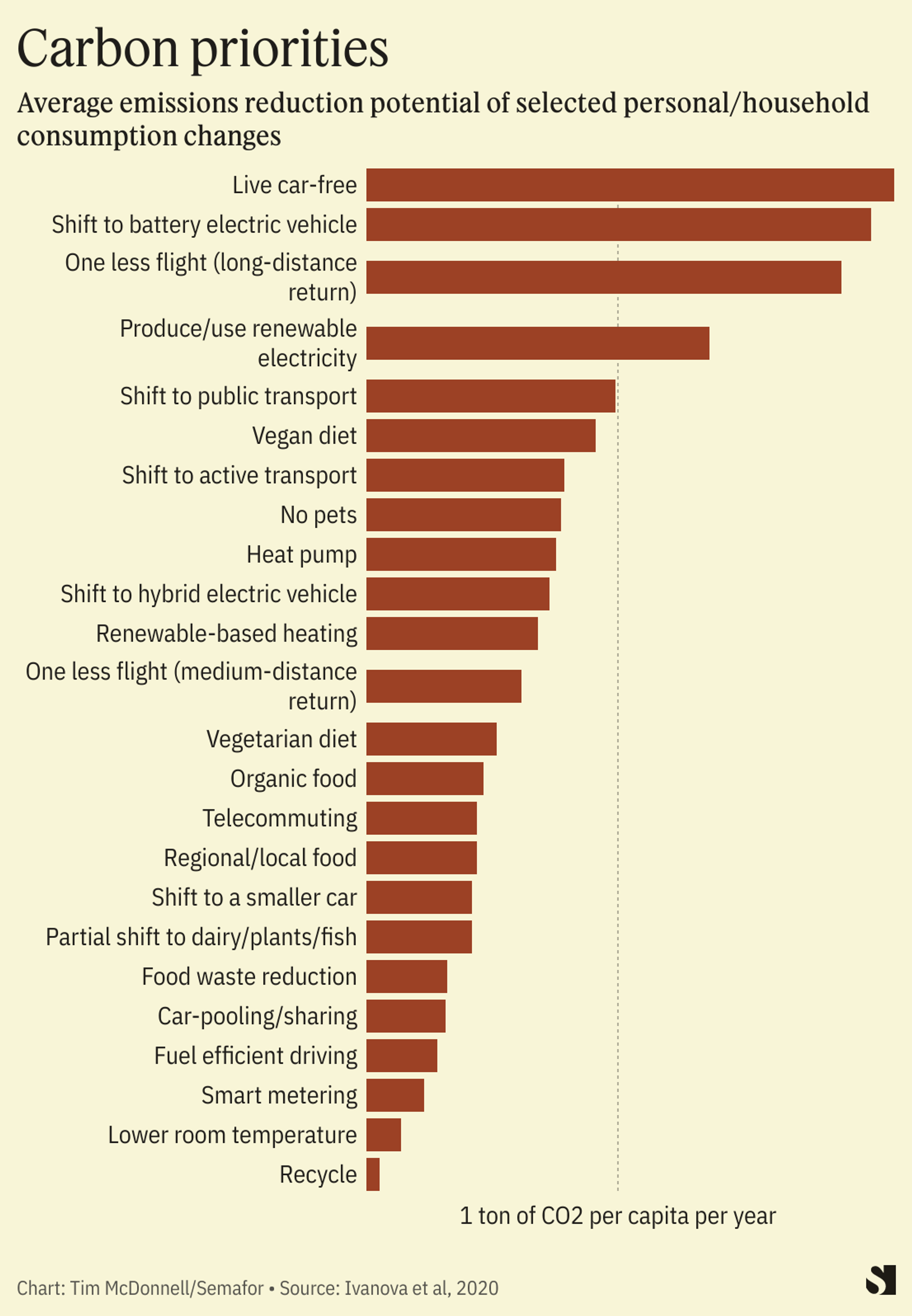The Scene
Sanchali Pal first started thinking about her carbon footprint as a university student working as a manager in her campus dining hall.
She began by researching the emissions associated with different foods at a time when she was wondering which, “if any,” of her “decisions mattered.” It inspired her to build a spreadsheet to track her bigger imprint. But even when she identified high-carbon activities, she couldn’t necessarily give them up: After graduation she got a job demanding frequent long-distance air travel. Other things, like the source of electricity in her rented apartment, were outside her control. But the spreadsheet showed that incremental shifts — one less flight per year, one less meal with meat per week — allowed her to quickly cut her emissions by a third.
In 2019, Pal launched an app, Commons, building off her spreadsheet. In analysis released today, she reported that users of the app typically reduce their emissions by 20% — and save an average of $200 a month on energy, food, and other expenses.
Tim’s view
Personal carbon footprint-accounting can be controversial, given that the carbon intensity of the economy is mostly the result of decisions made by a small number of corporations and governments, not of individual consumers. The first personal carbon footprint calculator was created in a marketing campaign by the oil major BP in 2004.
But individual emissions really do matter on a global scale. That was made clear in last year’s report from the Intergovernmental Panel on Climate Change, the first iteration to include a section on ways for individuals and households to reduce their demand for energy and other emissions-intensive goods and services. About 5% of global emissions could be wiped out tomorrow through consumer choices, and more than half through household-level investments like solar panels, electric vehicles, and heat pumps, Felix Creutzig, an environmental economist at the Technical University of Berlin and a lead IPCC author, said in an interview.
The most impactful ways to reduce personal emissions are familiar by now: Fly and drive less, eat less meat, switch to electric cars, and install electricity-based home heating. Quantifying the exact impact of these choices is tricky, Creutzig said, because everyone’s starting point is different. But he and colleagues provided a rough guide in a 2020 paper, which synthesized the results of 53 peer-reviewed studies covering more than 700 options for households or individuals to cut their emissions. The most impactful options, summarized in the following chart, nearly all address mobility and food.

Another crucial impact of these choices, Creutzig said, is that your neighbors notice: Social psychology studies indicate that peer modeling is one of the strongest drivers of behavioral change.
“Social contagion — what your neighbor does — is really important because it can amplify the effects of public policy,” he said.
Know More
Pal’s user data study indicates that her app’s users buy less gas, use more public transit, and eat less meat than the average American — unsurprising for a self-selecting group of people inclined to use a carbon-tracking app. But the data also indicate momentum within the group of users across those and other metrics, suggesting that the longer people stick with carbon tracking and the larger the social network of trackers becomes, the more changes people are willing or able to make.
On clothes shopping, for example, the number of Commons users who reported buying secondhand clothes increased 48% from 2021 to 2022. That suggests fashion — which is responsible for 10% of total global emissions — could be low-hanging fruit for consumer-driver reductions, Pal said. And, she added, it suggests that “sustainability has to be cool. When it’s in vogue, it becomes something people change behavior on very quickly.”
The View From Your Bank Account
One underappreciated source of personal emissions is bank accounts. Banks use deposits in retail checking and savings accounts to finance their commercial lending, which in the case of the biggest banks entails a lot of lending to the fossil fuel industry. Jae Easterbrooks, vice president of California-based Beneficial State Bank, said the bank’s exclusion of lending to fossil fuels has become a major selling point for new clients. 62% of Commons users reported moving their money into fossil-excluding banks after using the app.
The View From the 1%
Personal carbon footprints vary widely by income, with a person in the richest 10% of the global population on average emitting twice as much as someone in the poorest 50%, according to Oxfam. The top 1% of earners alone account for 15% of global consumption-related emissions. Most of that gap is explained, again, by transportation — especially extreme carbon culprits like superyachts and private jets — and energy consumption in big houses.
The richer you are, in other words, the greater your responsibility to cut your emissions. That’s especially true because the reduction of global poverty will entail rising per-capita emissions among the poorest, said Oxfam climate policy lead Nafkote Dabi.
Room for Disagreement
Individual consumer choices are limited by the availability of low-carbon infrastructure, Creutzig said: High-speed electricity transmission lines, EV charging stations, renewable energy farms, critical mineral mines, and so forth. So at a certain point, consumer choices matter less than political advocacy, including voting for climate-conscious politicians and pushing the managers of everything from school cafeterias to local zoning commissions to make more low-carbon choices available.
“Individuals aren’t responsible for everything,” Creutzig said, “but they do need to be responsible for engaging in public policy.”
Notable
- One possible way to motivate more climate-friendly consumer choices would be to adopt carbon cap-and-trade systems for individuals in the same way the EU and other jurisdictions have implemented them for industrial sectors, a group of Swedish researchers argued in a 2021 paper. Such a system would need to account for income gaps or risk placing a disproportionate burden on the poorest, they warn, but ideally it could “influence energy and consumption behavior by increasing carbon visibility, by evoking users’ cognitive awareness of carbon in their daily routines and by encouraging carbon budgeting.”
